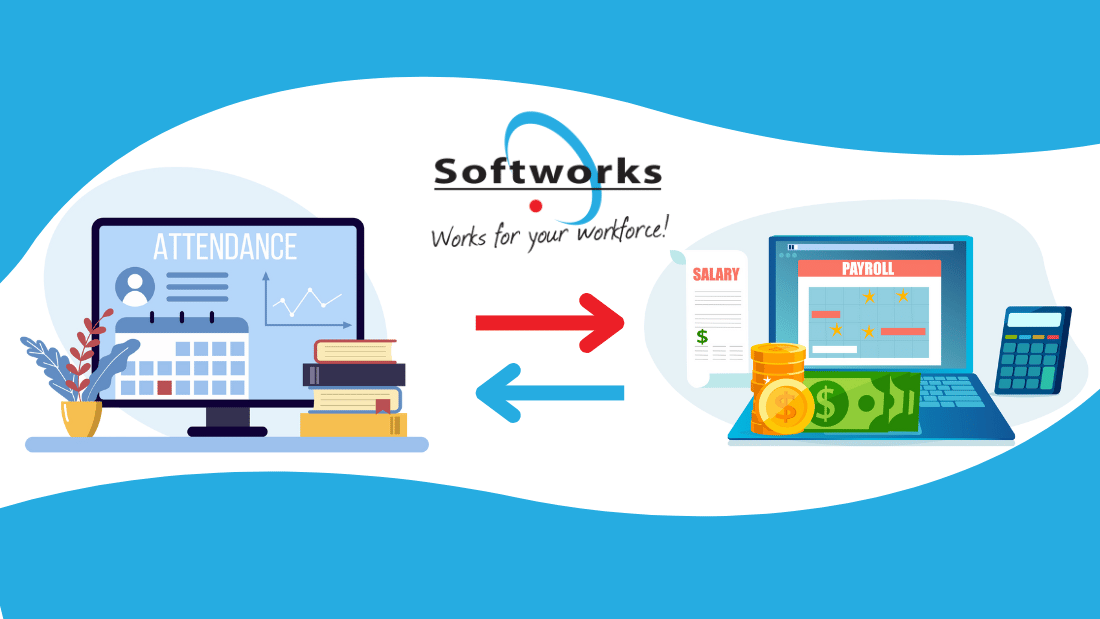Attendance Software and Payroll Systems integration has become a pivotal strategy for businesses seeking to enhance operational efficiency and payroll accuracy in today’s dynamic business environment. Integrations like these offer a seamless bridge between the time an employee works and their compensation, ensuring that the hours worked are accurately reflected in their paychecks. It eliminates the need for manual data entry, reduces the risk of errors, and saves time, ultimately leading to a more efficient payroll process.
Automated transfer of work hours into the payroll system eliminates the need for manual data entry, reduces the risk of errors, and saves time, leading to a more efficient payroll process.
Benefits of Attendance Software and Payroll Integration
The synchronization between time tracking and payroll processing is not just a convenience; it’s a cornerstone for maintaining accuracy and integrity in any organization’s payroll operations.
The case for integrating attendance software with payroll systems is compelling, and grounded in both operational efficiency and strategic advantage.

“Prior to Softworks we had to put hours into the payroll system manually and had to calculate basic and overtime hours. Softworks has greatly reduced the time needed for processing wages each week. In one area of the company it has halved the time we spend on payroll each week, it’s fantastic. We now have time for other priorities.”
CJ Sheeran, Ireland
It addresses several critical aspects of workforce management:
- Error Reduction: Manual data entry is prone to errors, which can lead to significant issues such as incorrect paychecks, dissatisfaction among employees, and even legal problems. Integrating these systems automates the transfer of data, drastically reducing the potential for these errors.
- Time Savings: The administrative burden of managing payroll is significantly lessened when the process is automated. It frees up HR and payroll staff to focus on more strategic tasks, such as employee engagement and performance management, rather than spending hours on data entry and verification.
- Improved Compliance: Labor laws and regulations are complex and constantly changing. An integrated system helps ensure that companies stay compliant by automatically applying the latest rules to working hours, overtime, and leave entitlements, thus minimizing the risk of legal issues and penalties.
- Real-Time Insights: Having a system that integrates time tracking with payroll processing provides real-time insights into labor costs and productivity. It allows for better forecasting, budgeting, and resource allocation, enabling managers to make informed decisions quickly.
- Employee Satisfaction: Prompt and accurate payment is a fundamental employee expectation. An integrated system ensures that employees are compensated correctly for their time, enhancing trust and satisfaction within the workforce.
- Streamlined Processes: Beyond the immediate benefits of accuracy and time savings, integrating these systems streamlines the entire payroll process. It enables a smoother flow of information, making it easier to manage employee data, track hours worked, and process payments efficiently.
The integration of attendance software with payroll systems is more than just a technical upgrade; it’s a strategic enhancement to the foundational aspects of workforce management. It aligns closely with the goals of modern businesses to operate more efficiently, comply with regulations, and keep their employees engaged and satisfied.
Essential Features of an Integrated System
For the integration of attendance software with payroll systems to be truly effective, certain key features are essential. These features not only facilitate the primary objectives of integration—efficiency, accuracy, and compliance—but also enhance the overall user experience for both employees and the payroll team.

Automated Data Flow
- Seamless Information Exchange: The ability to automatically transfer data between the attendance tracking and payroll processing components is the cornerstone of any integrated system. This automation eliminates the need for manual data entry, thereby reducing the likelihood of human error and saving considerable time.
- Reduced Manual Intervention: With automated data flow, the system minimizes the need for human intervention in the payroll process, leading to a more streamlined and efficient operation.
Error Detection and Correction
- Proactive Discrepancy Management: Integrated systems are equipped with tools to proactively identify and flag discrepancies between the attendance records and the payroll data. This capability ensures any anomalies are addressed before payroll processing, maintaining the accuracy of payments.
- Automated Corrections: Beyond detecting errors, these systems often offer automated correction mechanisms. They can adjust discrepancies based on predefined rules or guidelines, further enhancing the integrity of the payroll process.
Customizable Reporting
- Adaptability to Organizational Needs: The ability to customize reports is crucial for meeting the unique requirements of each organization. Integrated systems allow for the modification of report formats, data included, and frequency of generation to suit specific organizational or regulatory needs.
- Regulatory Compliance: Customizable reporting also plays a significant role in compliance management. Organizations can tailor reports to ensure they meet the documentation and reporting standards set by labor laws and financial regulations.
User-Friendly Interface
- Accessibility for All Users: A user-friendly interface ensures that the system is accessible and easy to use for all levels of users, from HR professionals and payroll administrators to managers and employees. This accessibility is vital for facilitating the adoption and effective use of the system across the organization.
- Empowering Users: By making the system intuitive, users can efficiently manage their tasks, whether it’s approving time sheets, processing payroll, or accessing pay slips. This empowerment can lead to higher satisfaction and productivity among staff.
The effectiveness of integrating attendance software with payroll systems hinges on these essential features. Automated data flow, error detection and correction mechanisms, customizable reporting, and a user-friendly interface work in concert to enhance the efficiency, accuracy, and user experience of payroll processing. These features not only streamline administrative tasks but also contribute to a more engaged and satisfied workforce.
Implementation Considerations
Successfully integrating attendance software with payroll systems requires thoughtful planning and consideration of several key factors. Organizations must take a structured approach to ensure the new system meets their needs and integrates smoothly with existing processes. Here are some critical steps and considerations to guide this process.

1. Assessing Organizational Needs
- Identifying Integration Requirements: Start by mapping out the specific needs your organization has for integration. Consider factors like the size of your workforce, the complexity of your payroll calculations, compliance requirements, and any unique scheduling or time-tracking needs.
- Stakeholder Input: Engage with stakeholders across the organization, including HR, payroll, IT, and operational managers, to understand their needs and expectations from the integration. This will help in creating a system that serves the entire organization effectively.
- Future Scalability: Assess not only your current needs but also plan for future growth. The chosen solution should be scalable to accommodate organizational changes and growth without requiring a complete system overhaul.
2. Choosing the Right Solution
- Compatibility with Existing Systems: Ensure that the attendance system you choose can seamlessly integrate with your existing payroll software. Compatibility reduces the need for extensive customizations, making the integration smoother.
- Comprehensive Feature Set: Look for systems that offer the essential features you identified during the needs assessment phase. Pay special attention to automated data flow, error detection and correction capabilities, customizable reporting, and a user-friendly interface.
- Vendor Reputation and Support: Choose a solution from a vendor with a strong reputation for reliability and customer support. Vendor support is crucial for resolving any issues that arise during and after the integration process.
3. Planning for Implementation
- Develop a Project Plan: Create a detailed project plan outlining key milestones, timelines, and responsibilities. This plan should include tasks such as data migration, system configuration, testing, and training.
- Testing and Validation: Before going live, thoroughly test the integrated system to validate the accuracy of data transfer and ensure all functionalities work as expected. Include real-world scenarios to test how the system handles different types of data and exceptions.
- Training and Support: Develop a comprehensive training program for all users, including payroll staff, HR managers, and employees. Ensure that users are comfortable with the new system before it goes live. Additionally, plan for ongoing support to address any questions or issues that arise after implementation.
Implementing an integrated attendance and payroll system is a significant undertaking that can lead to substantial benefits for an organization. By carefully assessing organizational needs, choosing the right solution, and planning meticulously for implementation, companies can ensure a smooth transition to a more efficient and accurate payroll processing system.
Challenges and Solutions
Integrating attendance software with payroll systems, while beneficial, presents several challenges. Addressing these challenges head-on with strategic solutions is key to a successful implementation. Here are some of the common challenges and practical solutions.

Data Security and Privacy
Challenge
One of the most significant concerns with any integration involving payroll and attendance systems is the risk to data security and privacy. These systems handle sensitive employee information, including personal details, salary data, and work hours, making them prime targets for cyber threats.
Solutions
- Encryption and Secure Data Transmission: Ensure that the integrated system uses advanced encryption standards for data at rest and in transit. This protects information from unauthorized access.
- Regular Security Audits: Conduct regular security audits and vulnerability assessments to identify and remediate potential security gaps in the system.
- Access Controls: Implement strict access controls, ensuring that only authorized personnel have access to sensitive payroll and attendance data. This minimizes the risk of internal breaches.
Change Management
Challenge
Resistance to change is a natural human tendency, and introducing new software tools can lead to apprehension among employees. Ensuring smooth adaptation requires careful management of the change process.
Solutions
- Effective Communication: Communicate the benefits and the reasons behind the change to all stakeholders well in advance. Clear communication helps in managing expectations and reducing resistance.
- Training and Support: Provide comprehensive training sessions tailored to different user groups. Offer continuous support after implementation to address any concerns and help users feel more comfortable with the new system.
- Feedback Mechanism: Establish a feedback mechanism to allow users to share their experiences and suggestions for improvement. This involvement can increase buy-in and adoption.
System Compatibility
Challenge
Ensuring that the new attendance software is compatible with existing payroll systems can be daunting. Incompatibility can lead to significant integration challenges, disrupting payroll operations.
Solutions
- Thorough Evaluation Before Selection: Before selecting an attendance system, conduct a thorough evaluation to ensure it is compatible with your current payroll software. This might involve technical assessments and consultations with both vendors.
- Custom Integration Solutions: In cases where off-the-shelf solutions do not perfectly align, consider custom integration solutions. Custom integrations can bridge the gap between different systems, ensuring seamless data flow.
- Vendor Collaboration: Encourage collaboration between your attendance software and payroll system vendors. Many vendors are willing to work together to ensure their products integrate well, especially if it means a successful client implementation.
By addressing these challenges with thoughtful and proactive solutions, organizations can smooth the path to successful integration of attendance software with payroll systems. This integration will lead to more efficient payroll processing, enhanced data accuracy, and ultimately, a more streamlined and effective workforce management process.
Conclusion
Integrating attendance software with payroll systems offers substantial benefits, including enhanced efficiency, accuracy, and compliance in payroll processing. This strategic move reduces administrative workload, minimizes errors, and improves employee satisfaction by ensuring accurate and timely compensation.
Successful integration, however, requires addressing key considerations such as assessing organizational needs, selecting compatible solutions, and carefully planning the implementation process. Challenges like data security, change management, and system compatibility must be managed effectively to ensure a seamless transition.
In summary, while the path to integration may present hurdles, the advantages it brings to workforce management make it a worthwhile endeavor. By navigating these challenges thoughtfully, organizations can unlock greater operational efficiency and foster a more engaged and satisfied workforce.
Request a free Demo!
Take the first step towards a complete workforce management solution. Talk to us today!
About Tomislav Rucevic
Tomislav Rucevic, an SEO Specialist at Softworks, stands out as more than just a marketer. He’s a fervent writer and influential thinker passionate about Workforce Management, HR, and work-life dynamics. Holding an MBA in Marketing, Tomislav excels in creating content that delves into the complexities of the modern workplace.
His dedication to writing on these topics is highlighted in his MBA thesis, which examined the link between Employee Motivation and Quality Improvement. At Softworks, he expertly merges his SEO skills with his writing prowess, contributing to the company’s digital success and advancing discussions on enhancing work environments and achieving work-life balance.









